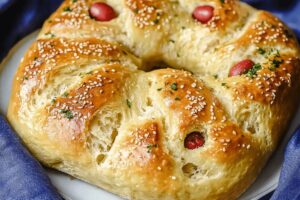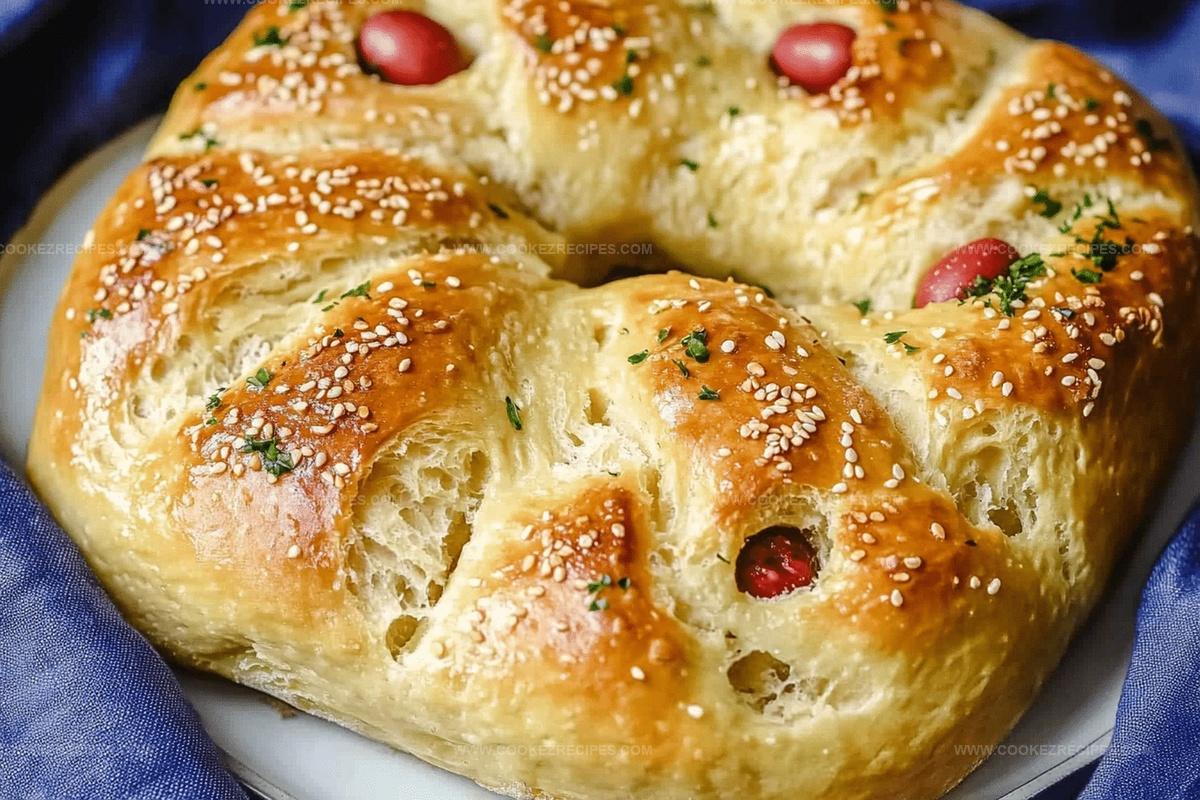Heavenly Greek Easter Bread Recipe for Holiday Magic
Baking this delightful greek easter bread transports me to sunny Mediterranean kitchens filled with warmth and tradition.
Memories of my grandmother kneading soft dough flood back with each gentle fold.
Fragrant spices whisper stories of generations past, blending cultural heritage into every slice.
Intricate braiding creates a gorgeous golden loaf that symbolizes renewal and celebration.
Sweet aromas will drift through your kitchen, promising a delectable experience.
Soft, pillowy textures and delicate hints of citrus make this bread irresistible.
Greek Easter Bread That Smells Like Tradition
Dough Mix in Greek Easter Bread
Bread Ingredients:Liquid Components:Flavor Enhancers and Binding Agents:Decoration and Finishing:Easy Greek Easter Bread Recipe – How to Bake
Step 1: Awaken the Yeast
Grab your stand mixer and pour in warm water.
Sprinkle in yeast, a touch of flour, and sugar.
Give it a gentle whisk and let it sit quietly for 10 minutes until it becomes bubbly and alive.
Step 2: Create Creamy Milk Base
Warm milk in a saucepan until tiny bubbles dance around the edges.
Remove from heat and blend in:Let the mixture cool and rest for a few moments.
Step 3: Build the Dough Foundation
Pour the milk mixture into the yeast blend.
Attach the paddle and start mixing.
Gradually add:Beat until a soft, pillowy dough forms and pulls away from the bowl’s sides.
Step 4: Knead with Love
Transfer the sticky dough to a floured surface.
Massage and stretch the dough for 5 minutes until smooth.
Nestle the dough in an oiled bowl, cover, and let it rise in a cozy spot for 1½ hours.
Step 5: Shape the Bread Wreath
Gently deflate the dough and divide into three equal ropes.
Braid these ropes loosely and form a circular wreath.
Pinch the ends together and stretch to create a beautiful 10-inch ring.
Step 6: Second Rise Adventure
Cover the bread with a clean towel.
Let it grow and expand in a warm space for another hour.
Step 7: Decorate with Colorful Eggs
Massage dyed hard-boiled eggs with olive oil.
Carefully nestle these eggs into three spots around the dough.
Allow one more hour of rising time.
Step 8: Bake to Golden Perfection
Heat the oven to 350°F.
Brush the bread with egg wash and sprinkle sesame seeds if desired.
Bake for 45 minutes until golden and sounds hollow when tapped.
Step 9: Welcome the Celebration
Allow the bread to cool for 30 minutes.
Serve alongside honey, additional eggs, or your favorite breakfast treats.
Enjoy the festive Greek tradition!
Easter Bread Tips The Greek Way
Greek Easter Bread Holds Flavor After Baking
Sweet Additions For Greek Easter Bread
Easy Greek Easter Bread Recipe Alternatives
FAQs
The eggs symbolize rebirth and resurrection in Greek Orthodox Easter traditions. The red-dyed eggs are baked directly into the bread as a cultural and religious symbol of new life.
Yes, you can substitute anise seed with other warm spices like ground cinnamon or ground cardamom. These alternatives will provide a similar aromatic quality to the bread.
This bread is a special Greek Easter bread called Tsoureki, which has unique characteristics like braided shape, inclusion of dyed eggs, and traditional spices like anise and vanilla that give it a distinctive flavor profile.
While the recipe requires multiple steps and some patience with rising times, it’s manageable for intermediate bakers. The key is following instructions carefully and being patient during the proofing stages.
Print
Easy Greek Easter Bread Recipe
- Total Time: 1 hour 15 minutes
- Yield: 12 1x
Description
Sweet Tsoureki bread weaves traditional Greek flavors into a delightful celebration of Easter traditions. Fragrant with orange zest and mahlepi spice, this bread brings Mediterranean warmth to your holiday table.
Ingredients
Main Dry Ingredients:
- 5 1/2 cups all-purpose flour
- 2 tablespoons anise seed
- 2 to 4 tablespoons toasted sesame seeds (optional)
Liquid and Binding Ingredients:
- 1 1/3 cups milk
- 5 tablespoons unsalted butter
- 2 large eggs, beaten
- 1 egg, beaten with 1 teaspoon water (for egg wash)
- 1/4 teaspoon vanilla extract
- Olive oil
Flavoring and Seasoning Ingredients:
- 2 1/4 teaspoons (1 envelope) active dry yeast
- 1/2 cup sugar
- 1 teaspoon fine salt
- 3 hard-boiled eggs, dyed red and fully dried
Instructions
- Awaken the yeast by whisking it with warm water, a touch of flour, and sugar in a stand mixer bowl. Allow the mixture to become frothy and bubbly over 10 minutes.
- Gently warm milk in a saucepan until edges shimmer, then remove from heat. Incorporate butter, remaining sugar, and salt. Cool the mixture for a brief moment.
- Merge the yeast and milk mixtures in the stand mixer. Introduce beaten eggs gradually while stirring with the paddle attachment. Fold in flour, fragrant anise seed, and vanilla extract until a soft, cohesive dough emerges.
- Transfer the sticky dough to a floured surface and knead meticulously for approximately 5 minutes, creating a smooth texture. Nestle the dough into an oiled bowl, drape with a cover, and let it rest in a warm environment until it doubles in volume.
- Deflate the risen dough and divide into three equal segments. Roll each portion into lengthy 16-inch strands. Arrange the ropes on a parchment-lined baking sheet, weaving them into a loose braid. Transform the braid into a circular shape, sealing the ends and stretching to create a 10-inch diameter with a central opening.
- Shield the shaped loaf with a clean cloth and allow a second rise in a warm space until the volume dramatically increases.
- Tenderly massage dyed hard-boiled eggs with olive oil, buffing them to a gentle sheen. Carefully nestle the eggs into predetermined spots within the dough. Return the loaf to its warm sanctuary for another hour of rising.
- Ignite the oven to 350°F. Lovingly brush the loaf with egg wash and sprinkle with toasted sesame seeds if desired. Bake until the bread transforms into a golden masterpiece, producing a hollow sound when tapped.
- Permit the bread to cool and settle for half an hour before presenting. Serve alongside additional eggs, a drizzle of honey, or complementary breakfast delicacies.
Notes
- Adapt the yeast activation temperature precisely to ensure proper rising, using a thermometer for accuracy.
- Knead the dough gently to maintain its delicate texture, avoiding overworking which can make the bread tough.
- Add sesame seeds or other toppings like sliced almonds for extra crunch and visual appeal.
- Experiment with alternative flavors by substituting anise seed with orange zest or cardamom for a different aromatic profile.
- Prep Time: 30 minutes
- Cook Time: 45 minutes
- Category: Breakfast, Snacks, Desserts
- Method: Baking
- Cuisine: Greek
Nutrition
- Serving Size: 12
- Calories: 300
- Sugar: 9 g
- Sodium: 150 mg
- Fat: 10 g
- Saturated Fat: 5 g
- Unsaturated Fat: 4.5 g
- Trans Fat: 0 g
- Carbohydrates: 42 g
- Fiber: 1 g
- Protein: 7 g
- Cholesterol: 50 mg


Daniel Bruns
Founder & Culinary Innovator
Expertise
Recipe development for home cooks, Nutritional analysis and meal planning, Culinary education and food writing
Education
Auguste Escoffier School of Culinary Arts
Diploma in Culinary Arts and Operations
Focus: Classical and contemporary cooking techniques, Culinary entrepreneurship and kitchen management, Menu development and food cost analysis
Daniel’s story started with flour on his face and a pie in the oven at his grandma’s house. He later sharpened his skills at the Auguste Escoffier School of Culinary Arts.
His goal? Recipes so simple you’ll want to cook every night. When he’s not whipping up one-pan wonders, Daniel’s outside picking herbs, hosting neighborhood cook-offs, or baking chocolate cakes with his kids, messy, sweet, and unforgettable.